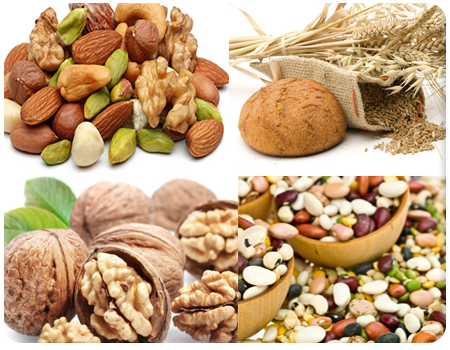Dietary Fiber
Dietary Fiber includes a number of polysaccharides and lignin that are not digested by the enzymes of the gastrointestinal tract. These nonnutritive substances have specific chemical structures with varying physical and chemical properties) their quantitative determination in foods
Cellulose is the most abundant molecule it nature and is the principal structure of cell walls.
Lignin is a water-insoluble component that makes up the woody part of plants. Legumes and fruits with seeds and the lignified cells of pears are important sources. Whole-grain cereals are moderate in lignin content, whereas most vegetables are low.
 |
Hemicelluloses are found in the cell walls of many plants. The hemicelluloses are soluble in hot water and occur in a variety of plant foods: carrots, cabbage, celery, leafy vegetables, apples, melons, peaches, pears, and whole-grain cereals
Pectin is soluble in hot water and has the capacity to hold water and to form gels. Apples and citrus fruits are important sources, while cereals contain very little) cereals contain very little).
Pectins are used in making fruit jellies. Agar obtained from seaweed is also useful for its gelling properties.
Mucilages and gums are nonstructural components of plant cells that are soluble in hot water
Carrageen (Irish moss) and alginates from seaweed are often used to enhancethe smoothness of foods such as ice creamand evaporated milk). |
FUNCTIONS:
|
-
Dietary fiber holds water so that stools are soft, bulky, and readily eliminated. Coarse bran is effective but fine bran has little effect. It is generally agreed that a high-fiber intake prevents or relieves constipation. The large, bulky stool also represents a dilution of colon contents so that any potentially toxic substances such as carcinogens that might be present would thus be less harmful.
-
Fiber generally increases motility of the small intestine and colon and decreases transit time. This could result from the stimulation of the mucosa by mechanical effect or perhaps by the by-products of bacterial fermentation. If transit time is shortened, then there could be less time for exposure of the mucosa to harmful toxicants. Also, there could be less time for bacteria to produce harmful substances.
-
Pectins, mucilages, and gums retard gastric emptying. This can have two benefits: increased satiety so that less food is eaten, thus helping to keep energy intake within the requirement; and a smoother response by the blood circulation to glucose and hence lesser insulin secretion. This effect is one explanation for the lower insulin requirement observed in diabetic patients who' consume a high-carbohydrate high-fiber diet.
-
High-fiber diets have been found to reduce intraluminal pressure in the colon of some persons who have diverticulitis or irritable colon.
-
High-fiber diets, such as vegetarian diets, have somewhat lower coefficients of digestibility. Thus, the net energy realized to the body is a little less than that from diets containing high proportions of animal foods.
|
-
Cellulose and lignin have the capacity to bind minerals such as calcium, magnesium, phosphorus, zinc, and others.
-
Pectins, mucilages, and gums chelate with bile acids and steroid materials. The chelating effect helps to explain the reduction in blood cholesterol levels. But it must also be recognized that the lipid-lowering effect could be associated with the reduced level of fats that is characteristic of many high-fiber diets. Rolled oats and some legumes have been found effective in bringing about modest lowering of the blood cholesterol but the bran of wheat has had no such result.
-
Pectins, hemicelluloses, gums, and mucilages are partially fermented by intestinal bacteria to volatile fatty acids, carbon dioxide, and methane. The caloric yield to the body by this fermentation accounts for only about 5 per cent of the caloric equivalent of the total fiber ingested and is of no practical significance.
|
 |
Source
Tomris AltuŃg. 2002. Introduction to Toxicology and Food: Toxin Science, Food Toxicants, Chemoprevention. CRC Publication.
Robinson,C.N and Lawler, M.R 16 Edition. Normal and Therapeutic Nutrition. Oxford and IBH Publishing Co, Delhi.
http://4.bp.blogspot.com/s400/P1010303a.jpg http://www.diamondorganics.com/images
http://materiaaromatica.com/UsedImages/ThickBox_coriander.jpg
http://skinbeautifulblog.files.wordpress.com/2008/09/fruits.jpg |
|


